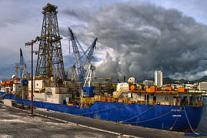The University of Louisiana at Lafayette has taken its place in the top level of the nation’s research institutions
Research findings could affect oil and gas exploration
Wed, 07/09/2014 - 3:56pmSamples of earth extracted from deep beneath the sea, off the coast of Spain and Portugal, show climate shifts as early as 6 million years ago.
But a University of Louisiana at Lafayette researcher said other clues revealed in those samples may be even more significant, especially for the oil and gas industry.
Dr. Carl Richter, a geologist in the University’s School of Geosciences, is one of 35 scientists from 14 countries who participated in Integrated Ocean Drilling Program Expedition 339. From November 2011 to January 2912, they worked on board "JOIDES Resolution," a research vessel.
The team’s findings are published in the June 13 issue of "Science" magazine.
During the expedition, the scientists took core samples from a three-mile stretch near the Strait of Gibraltar, which is a gateway between the Atlantic Ocean and the Mediterranean Sea. They then examined the sedimentary record produced there by strong ocean currents, commonly called Mediterranean outflow water.
“Our initial goal was to understand how the Strait of Gibraltar acted first as a barrier and then as a gateway over the past 6 million years as the currents passed through the area,” Richter said. “Because the Mediterranean outflow water is saltier and heavier than the Atlantic waters, it plunges more than 3,000 feet downslope, carving deep-sea channels, and building up mountains of mud in these unique underwater landscapes. We now have first results for understanding the history of these currents through the Gibraltar gateway.”
The scientists also found new evidence of “a deep-earth tectonic pulse” in the region. Shifts in the Earth’s crust are believed to be a major cause of environmental change.
Richter said the sediments collected during the expedition indicate that “oceans and climate are closely linked.”
Further analysis showed that the sediments contained far more sand than expected. A sheet of sand extends about 60 miles from the Gibraltar gateway; it is evidence of the strength and velocity of Mediterranean currents.
The research team’s findings could impact future oil and gas exploration, according to the geologist.
“The thickness, extent, and properties of these sands make them an ideal target in places where they are buried deeply enough to allow for the trapping of oil and gas,” he said.
The research team’s abstract notes: “These sands represent a completely new and important exploration target for potential oil and gas reservoirs.”
Expedition 339 was funded by the U.S. National Science Foundation and implemented by the Integrated Ocean Drilling Program – U.S. Implementing Organization. The research was partially supported by European grants and the Continental Margins Research Group at Royal Holloway University of London.
For more information about this IODP Expedition, visit
http://iodp.tamu.edu/scienceops/expeditions/mediterranean_outflow.html
Photo credit: John Beck, IODP/TAMU
Expedition 339 started in Ponta Delgada, Azores, in November 2011. An international team of scientists was on board the JOIDES Resolution, the research vessel shown.

